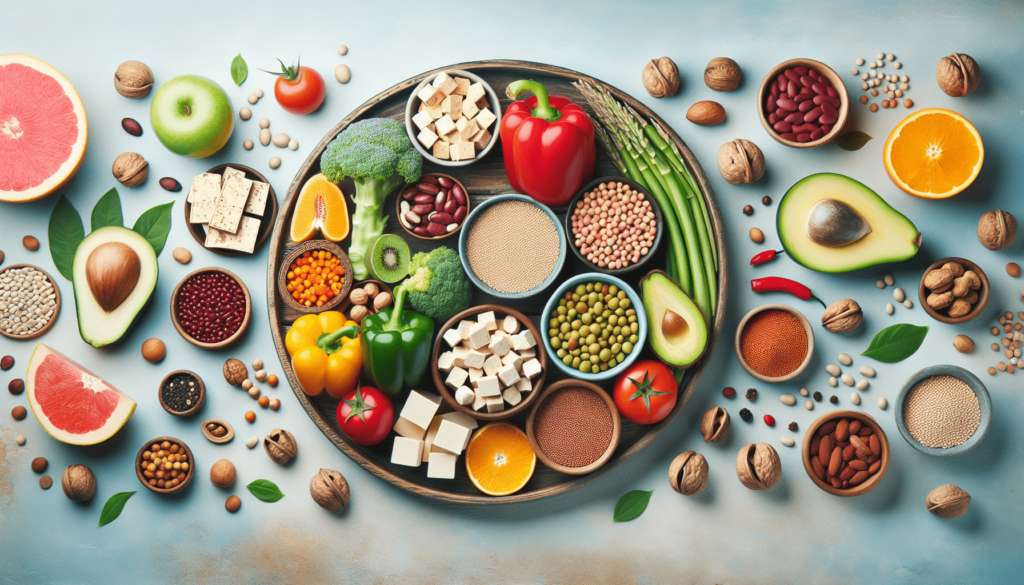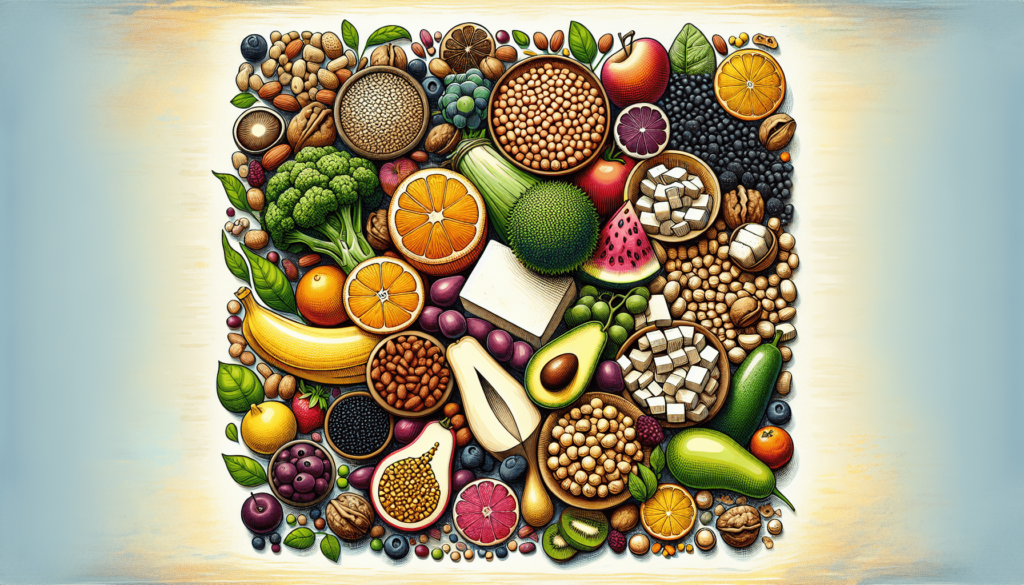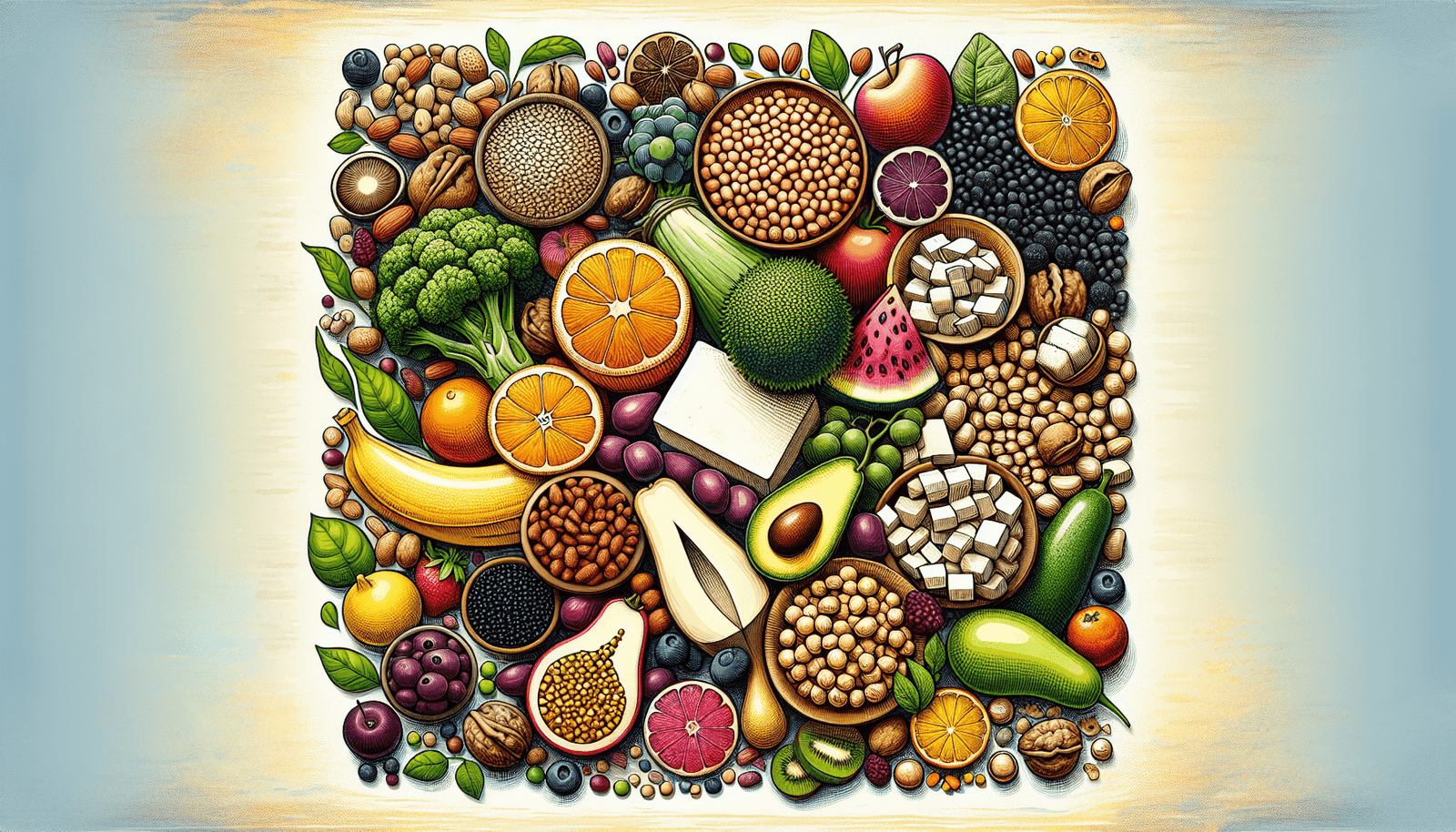Are you looking for a delicious and sustainable way to increase your protein intake without relying on meat? Look no further than plant-based protein! With a rising interest in plant-based diets and the undeniable benefits they offer, incorporating plant-based protein into your meals is not only good for your health but also for the planet. In this article, we will explore the various plant-based protein sources available, their nutritional benefits, and how you can easily incorporate them into your diet. Get ready to discover the world of plant-based protein and meet your protein needs without ever missing the meat!

What is plant-based protein?
Definition of plant-based protein
Plant-based protein refers to protein sources that are derived from plants, such as legumes, grains, soy, seeds, nuts, and vegetables. These sources offer an alternative to animal-based proteins, making them suitable for vegetarians, vegans, and those looking to reduce their consumption of animal products.
Examples of plant-based protein sources
There is a wide range of plant-based protein sources available, each with its unique nutrient profile. Legumes, including beans, lentils, and chickpeas, are excellent sources of protein, fiber, and various vitamins and minerals. Whole grains, such as quinoa, brown rice, and oats, also contain protein and other nutrients. Soy products like tofu, tempeh, and edamame are complete sources of plant-based protein. Seeds and nuts, such as chia seeds, almonds, and hemp seeds, offer both protein and healthy fats. Additionally, vegetables like spinach, broccoli, and peas contribute protein to a plant-based diet.
Nutritional benefits of plant-based protein
Complete vs incomplete plant-based proteins
Protein is made up of amino acids, and some plant-based protein sources may lack certain essential amino acids. However, by combining different plant-based protein sources, you can obtain a complete amino acid profile. For example, combining legumes with grains provides all the essential amino acids your body needs.
High fiber content
Plant-based protein sources are often rich in fiber, which offers numerous health benefits. Fiber helps regulate digestion, manages blood sugar levels, promotes satiety, and supports a healthy gut microbiome. Animal-based proteins usually lack fiber, making plant-based options a preferable choice.
Vitamins and minerals
Plant-based protein sources are not only nutritious in terms of protein content but also provide a wide array of essential vitamins and minerals. Legumes, for instance, are excellent sources of iron, folate, and potassium. Similarly, dark leafy vegetables like spinach and broccoli contain vitamins A, C, and K, as well as minerals like calcium and magnesium.
Lower saturated fat content
Compared to many animal-based protein sources, plant-based proteins generally have lower levels of saturated fat. By choosing plant-based proteins, you can reduce your intake of saturated fat, which is linked to an increased risk of heart disease and other health issues.
Heart-healthy benefits
Plant-based protein sources, including legumes, whole grains, and nuts, have been linked to a reduced risk of cardiovascular diseases. They often contain heart-healthy fats, omega-3 fatty acids, and other nutrients that can help improve cholesterol levels and promote cardiovascular health.
Meeting protein needs on a plant-based diet
Recommended protein intake
The recommended daily intake of protein varies depending on factors such as age, sex, activity level, and overall health. However, a general guideline is to consume around 0.8 grams of protein per kilogram of body weight. This means that for a 68-kilogram (150-pound) individual, the daily protein requirement would be approximately 55 grams.
Calculating protein needs based on body weight
To calculate your specific protein needs, multiply your weight in kilograms by the recommended protein intake per kilogram. For example, if you weigh 68 kilograms, you would multiply this by 0.8 grams of protein, resulting in a daily protein requirement of 55 grams.
Combining plant-based protein sources for complete amino acid profile
By combining different plant-based protein sources, you can ensure a complete amino acid profile. For example, pairing legumes with whole grains creates a complementary amino acid profile that supplies all the essential amino acids your body needs. Adding seeds or nuts to meals can further enhance the protein content and improve the overall nutrient profile.

Common plant-based protein sources
Legumes (beans, lentils, chickpeas)
Legumes are a versatile and widely available plant-based protein source. They are also rich in fiber, vitamins, and minerals. Beans, lentils, and chickpeas can be incorporated into various recipes, including salads, soups, stews, and even veggie burgers.
Whole grains (quinoa, brown rice, oats)
Whole grains are not only a great source of fiber but also provide protein. Quinoa, brown rice, and oats are excellent examples. They can be used as a base for grain bowls, added to salads, or used in baking to increase the protein content of your meals.
Soy products (tofu, tempeh, edamame)
Soy products are complete sources of plant-based protein, containing all the essential amino acids. Tofu, tempeh, and edamame are versatile options that can be used in stir-fries, salads, and sandwiches. They are also available in various textures and flavors.
Seeds and nuts (chia seeds, almonds, hemp seeds)
Seeds and nuts not only provide protein but also offer healthy fats, vitamins, and minerals. Chia seeds, almonds, and hemp seeds are great options. They can be sprinkled over yogurt or oatmeal, added to smoothies, or used as toppings for salads and roasted vegetables.
Vegetables (spinach, broccoli, peas)
Although vegetables are not typically considered primary protein sources, they still contribute to the overall protein intake. Dark leafy greens like spinach, cruciferous vegetables like broccoli, and peas are nutrient-dense and contain a moderate amount of protein. Incorporating them into salads, stir-fries, and pasta dishes can boost your plant-based protein intake.
Preparing and cooking plant-based protein
Soaking and sprouting legumes
Soaking and sprouting legumes before cooking can enhance their nutritional profile and make them more easily digestible. Soaking legumes overnight helps reduce the levels of antinutrients, which can inhibit mineral absorption. Sprouting legumes, on the other hand, increases their vitamin and mineral content.
Food processing techniques for optimal protein absorption
Some plant-based proteins, such as legumes and whole grains, contain antinutrients like phytates and lectins that can interfere with protein absorption. However, cooking, fermenting, or processing these foods can minimize the impact of antinutrients and enhance protein absorption. For example, fermenting soybeans produces miso and tempeh, which have improved digestibility and protein bioavailability.
Marinating and flavoring plant-based proteins
Marinating plant-based proteins like tofu, tempeh, or seitan can enhance their taste and texture. Marinades made with ingredients like soy sauce, citrus juices, herbs, and spices can add flavor and help tenderize the proteins. Similarly, using flavorful sauces, herbs, or spices when cooking legumes or whole grains can make them more enjoyable and fulfilling.
Cooking methods (boiling, steaming, baking, grilling)
Different cooking methods can be used to prepare plant-based proteins and retain their nutritional value. Boiling legumes until they are soft and tender is a common method. Steaming vegetables and grains help preserve their nutrients while maintaining their texture. Baking and grilling tofu, tempeh, or vegetables can add flavor and create a crispy texture.
Supplementing plant-based protein
Protein powder options (pea protein, rice protein, hemp protein)
Protein powders, derived from plant sources like peas, rice, and hemp, offer a convenient way to supplement your protein intake. These powders can be added to smoothies, oatmeal, or baked goods to increase the protein content of your meals. Be sure to choose protein powders without added sugars or artificial ingredients.
Protein bars and snacks
Protein bars and snacks made from plant-based protein sources are widely available and can be a convenient option for on-the-go protein consumption. Look for bars and snacks with minimal added sugars and natural ingredients to ensure they provide a healthy source of plant-based protein.
Adding protein-rich ingredients to meals (nutritional yeast, spirulina, seitan)
Incorporating protein-rich ingredients like nutritional yeast, spirulina, or seitan into your meals can boost your plant-based protein intake. Nutritional yeast adds a cheesy flavor and can be sprinkled on top of dishes. Spirulina, a blue-green algae, can be added to smoothies or used as a natural food coloring. Seitan, made from wheat gluten, can be used in stir-fries or as a meat substitute in various recipes.
Athletes and plant-based protein
Benefits of plant-based protein for athletes
Plant-based protein sources offer numerous benefits for athletes, including muscle recovery, improved performance, and reduced inflammation. These proteins provide the necessary amino acids for muscle repair and growth without the high saturated fat content found in many animal-based proteins.
Recommended protein intake for athletes
Athletes have higher protein requirements than the average person due to increased physical activity and muscle protein synthesis. Endurance athletes may require around 1.2 to 1.4 grams of protein per kilogram of body weight, while strength training athletes may need up to 1.6 to 1.8 grams per kilogram.
Meal planning for optimal performance
Athletes following a plant-based diet should prioritize meal planning to ensure they meet their protein and nutritional needs. Including a variety of plant-based protein sources, such as legumes, whole grains, soy products, and nuts, in each meal can help athletes reach their protein goals. Additionally, incorporating carbohydrates, healthy fats, and antioxidants from fruits and vegetables can support optimal performance and recovery.
Plant-based protein for weight loss
High satiety factor
Plant-based protein sources tend to have a high satiety factor, meaning they help you feel fuller for longer. This can be particularly beneficial for weight loss, as it reduces the likelihood of overeating between meals. By including plant-based proteins in your diet, you can maintain satiety and minimize snacking on unhealthy foods.
Reduced calorie density
Compared to many animal-based proteins, plant-based protein sources often have a lower calorie density. This means you can consume a larger volume of food for the same number of calories. By choosing plant-based proteins, you can feel more satisfied with fewer calories, making it easier to manage your weight.
Replacing unhealthy animal products with plant-based alternatives
Switching from unhealthy animal products to plant-based alternatives can aid in weight loss. Plant-based proteins like legumes, tofu, and tempeh can be used as substitutes for high-fat meats. This substitution reduces your daily calorie and saturated fat intake, helping you achieve your weight loss goals.
Potential challenges and considerations
Iron and B12 supplementation
While plant-based diets can provide sufficient iron and vitamin B12 when properly planned, some individuals may need supplementation. Iron from plant-based sources is less easily absorbed than iron from animal-based products. Including vitamin C-rich foods with iron sources can enhance absorption. Vitamin B12, which is primarily found in animal products, should be obtained through fortified foods or supplements.
Balancing macronutrient intake
Properly balancing macronutrient intake is important for a healthy plant-based diet. While protein is a crucial component, it is essential to also include carbohydrates and fats in appropriate proportions. Incorporating whole grains, legumes, fruits, vegetables, and healthy fats like avocados or nuts can help achieve a balanced nutrient profile.
Food allergies and sensitivities
Individuals with food allergies or sensitivities must be mindful when following a plant-based diet. Certain plant-based proteins like soy, nuts, and gluten-containing grains can trigger allergic reactions or digestive issues in susceptible individuals. It is important to diversify protein sources and consult with a healthcare professional if you have specific dietary restrictions.
Cultural and social factors
Transitioning to a plant-based diet can be influenced by cultural and social factors. It is essential to consider individual preferences, family traditions, and social events when adopting a plant-based eating pattern. Open communication, education, and flexibility can help navigate these challenges in a friendly and supportive manner.
Tips for incorporating plant-based protein
Gradual transition to plant-based eating
If you are new to plant-based eating, consider making a gradual transition by incorporating one or two plant-based protein sources into your meals each day. This allows your taste buds to adapt, and it gives you the opportunity to explore different flavors and textures.
Experimenting with new recipes and flavors
A plant-based diet offers a wide variety of fruits, vegetables, grains, and legumes that can be combined into delicious and nutritious meals. Experimenting with new recipes and flavors can make the transition to plant-based eating more enjoyable. Look for cookbooks or online resources for inspiration, and try different spices and herbs to enhance the taste of your dishes.
Meal planning and prepping
Meal planning and prepping can save time, ensure balanced nutrition, and make it easier to incorporate plant-based protein into your meals. Set aside time each week to plan your meals, create a shopping list, and prepare ingredients in advance. Consider batch cooking legumes, grains, and tofu, so they are ready to use throughout the week.
Educating yourself about plant-based nutrition
To ensure you are meeting your nutritional needs on a plant-based diet, take the time to educate yourself about plant-based nutrition. Learn about the different plant-based protein sources, how to ensure a complete amino acid profile, and how to balance your macronutrient intake. Consulting with a registered dietitian who specializes in plant-based diets can also provide personalized guidance and support.
In conclusion, incorporating plant-based protein into your diet offers numerous nutritional benefits, including providing essential amino acids, high fiber content, vitamins and minerals, lower saturated fat, heart-healthy benefits, and support for weight loss. Meeting your protein needs on a plant-based diet involves calculating your specific protein requirements, combining plant-based protein sources, and exploring common plant-based protein sources. Preparing and cooking plant-based proteins can be optimized through soaking and sprouting legumes, utilizing proper food processing techniques, marinating and flavoring, and using various cooking methods. Supplementing plant-based protein can be achieved through protein powder options, protein bars and snacks, and incorporating protein-rich ingredients into meals. Athletes can also benefit from plant-based protein, but should be mindful of their increased protein needs and plan meals accordingly. Plant-based protein is advantageous for weight loss due to its high satiety factor, reduced calorie density, and the ability to replace unhealthy animal products. However, some challenges and considerations should be kept in mind, such as the need for iron and B12 supplementation, balancing macronutrient intake, navigating food allergies and sensitivities, and addressing cultural and social factors. Incorporating plant-based protein can be achieved through a gradual transition, experimenting with new recipes and flavors, meal planning and prepping, and educating oneself about plant-based nutrition. By embracing plant-based protein, you can meet your nutritional needs without meat and enjoy a variety of delicious and nutritious meals.

